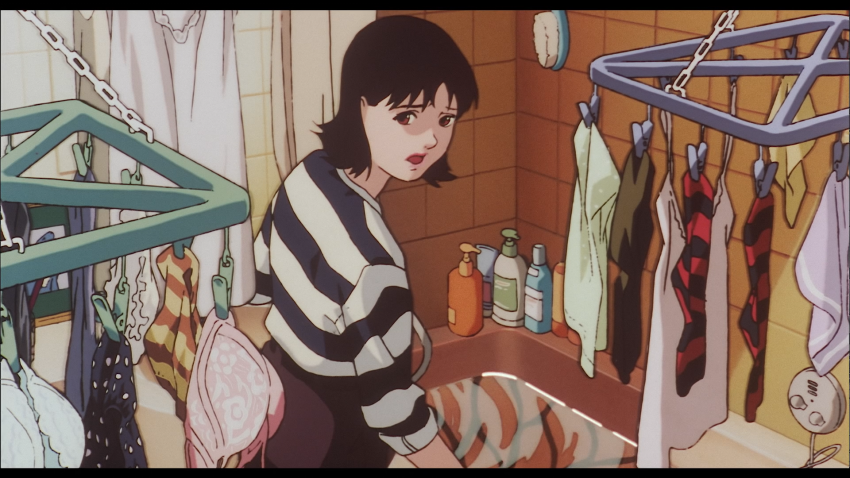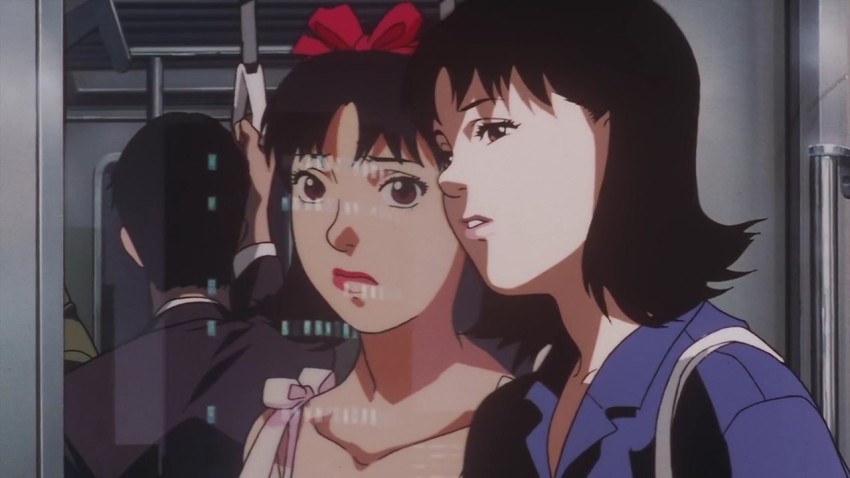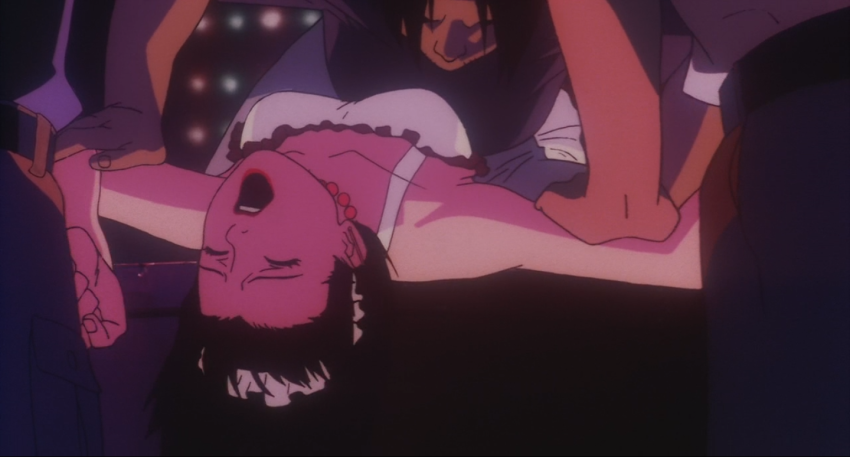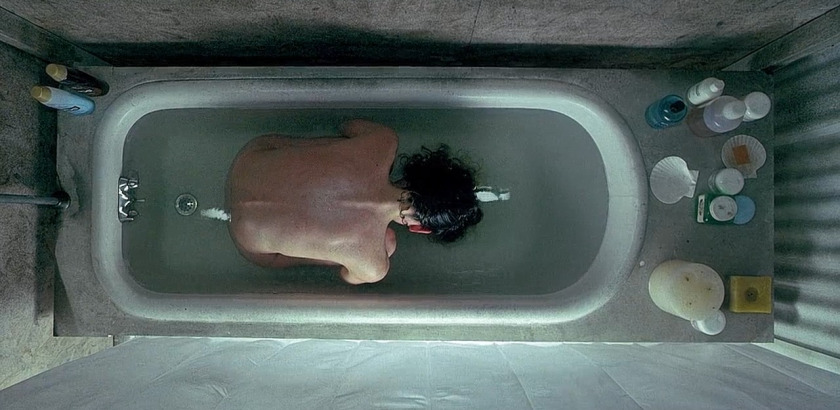Kon on Perfect Blue
April 27, 2019 · 0 comments
By Andrew Osmond.
 “Perfect Blue is a very twisted film. Please keep in mind that (this) will be my personal interpretation and it is not necessarily the right way to interpret the film.”
“Perfect Blue is a very twisted film. Please keep in mind that (this) will be my personal interpretation and it is not necessarily the right way to interpret the film.”
So begins the video talk by director Satoshi Kon included on the Perfect Blue Ultimate Edition. Recorded around 2007, the video shows Kon looking back a decade to his directorial debut, giving his interpretation of one of the most-analysed anime ever.
(The following has spoilers for the end of the film.)
Perhaps Kon put in the disclaimer to avoid alienating fans who had already “solved” Perfect Blue to their satisfaction. Kon’s experience of being interviewed about the film would have made him aware that people were coming out of Perfect Blue with very different takes on it. He might even have seen the contemporary response of Britian’s Manga Max magazine. It ran an article called “Will The Real Perfect Blue Please Stand Up?” in which different writers argued it was “a malevolent, brooding morality play”: or a tribute to Italian giallo horror-thrillers; or a repetition of Hitchcock’s “mistake” in his 1943 Stage Fright, of misleading the audience with untrue scenes.
In the video presentation, Kon mentions interviewers asking him about the film’s last shot, which is of Mima smiling in a car mirror. Was there, Kon was asked, some buried hint in the use of a mirror, one of the film’s motifs? Was it hinting that Mima, the flesh-and-blood Mima, was the murderer all along? Kon himself didn’t mean the shot that way. Instead, he explains, he showed Mima’s reflection to suggest a subtler ambiguity. Mima may say she’s real but Kon’s take is there’s no such thing as a finished “real” person; we’re all unending works in progress.
Yet Kon also acknowledges that the multiple interpretations of different viewers, including ones like Mima is the murderer, enrich a film like Perfect Blue. “Some of the people who’ve told me their impressions of the film asked if I didn’t just pull a (fast) one on them,” he says. “And that’s when I think I hit the jackpot.” Kon would have loved the documentary Room 237, about fans’ different takes on Kubrick’s The Shining, perceiving the film as being “about” everything from the Minotaur legend to the moon-landing which Kubrick helped fake in 1969. (Allegedly)
 Kon’s comments also shed light on how Perfect Blue’s commercial history shaped its content. Looked at in retrospect, Perfect Blue is far more violent and bloody than any of Kon’s later anime. “It was supposed to be an OVA (a direct-to-video anime),” Kon explains. “We didn’t know it was to be released in cinemas. So we thought we had to make it stand out as much as possible. OVAs don’t get a lot of publicity. So I thought we should have a graphic scene, but I went too far.”
Kon’s comments also shed light on how Perfect Blue’s commercial history shaped its content. Looked at in retrospect, Perfect Blue is far more violent and bloody than any of Kon’s later anime. “It was supposed to be an OVA (a direct-to-video anime),” Kon explains. “We didn’t know it was to be released in cinemas. So we thought we had to make it stand out as much as possible. OVAs don’t get a lot of publicity. So I thought we should have a graphic scene, but I went too far.”
The OVA format began in the 1980s, soon after home video itself (the first OVA was the 1983 space series Dallos). Many took the medium into excesses of sex and horror. For example, Perfect Blue includes glimpses of Mima’s pubic hair in her nude photo-shoot. In Japan, depictions of pubic hair had been long prohibited, a ban only lifted in 1991.
Such anime videos were often sold to the West. They were often one-offs or compact series of a few episodes, which didn’t tie distributors into lengthy serials that would need a shelf’s-worth of tapes. Moreover, the lurid OVAs could be marketed easily. One anime studio which sold OVAs to the West was Madhouse, which made horror videos like Wicked City and Doomed Megalopolis. But it also chanced making violent cinema anime. Ninja Scroll (1993) was one; another was Perfect Blue, upgraded to a cinema film during its development.
Kon is frank about how the expectations tied up with the OVA format led him to push Perfect Blue further, even though it ended up in cinemas. This particularly applies to the central scene of Mima’s non-literal “rape”, when she endures a rape scene in a TV drama and ends up traumatised. “This scene was too graphic,” Kon says. “When I saw this blown up on a cinema-size screen, I ended up looking down.”
Notably, Kon seemed more uncomfortable with the scene than the Japanese censor board was. While Perfect Blue was rated 18 in Britain, it was rated only R-15 in Japan, which Kon himself thought was too low. “I was prepared for an R-18… I question letting high school students watch this. (But) I guess they (the censors) felt this movie was very serious.”
 Kon adds, “They said that if we changed two, three scenes, we can get a G rating” [the equivalent of U, meaning suitable for everyone]. This sounds outrageous, given the shocking scenes in the film… yet there aren’t actually so many of them. It’s quite possible to imagine a version of Perfect Blue with no more on-screen violence than the defining psycho-thriller, Hitchcock’s Psycho, and perhaps less than that. Imagine, for example, a version of the “rape” where we just hear the assault, focusing on the faces of Rumi and Tadokoro.
Kon adds, “They said that if we changed two, three scenes, we can get a G rating” [the equivalent of U, meaning suitable for everyone]. This sounds outrageous, given the shocking scenes in the film… yet there aren’t actually so many of them. It’s quite possible to imagine a version of Perfect Blue with no more on-screen violence than the defining psycho-thriller, Hitchcock’s Psycho, and perhaps less than that. Imagine, for example, a version of the “rape” where we just hear the assault, focusing on the faces of Rumi and Tadokoro.
Instead, Kon admits to pushing the violent imagery. “There was actually more in the storyboard, but we just couldn’t….” (In the storyboard, Mima has two successive attackers.) The most uncomfortable part of Kon’s talk relates to the thrusting of Mima’s “rapist”, and Kon’s speculating how much censors would allow. Viewers may find this disgusting, especially with such off-the-cuff remarks from Kon as “Some people did think we were just having fun (with a rape scene).”
Still, Kon surrounds the scene in the film with an elaborate circle of mirrors. It involves a fictional character; an animated character; and a character who’s not “actually” being raped in the story. For Kon, the scene’s significance is as the public death – indeed, the killing – of Mima’s persona as a pop idol. In the talk, Kon draws attention to the shot of Mima after the rape. She’s wearing black clothes, her head bowed as if in mourning and prayer; no more defiling, just loss.
Quite probably it was such moments which interested the American director Darren Aronofsky. “He said he wanted to make Perfect Blue into a live-action film,” Kon recalls. “He’s supposedly a real fan of the movie, and I actually got to talk with him when he came here for Requiem for a Dream” – presumably to promote his 2000 film about the lives of drug addicts.
As many fans know, Requiem reconstructs a moment in Perfect Blue, where a female character (played in Requiem by Jennifer Connolly) submerges in a bath, then screams explosively underwater. But Kon goes beyond that, pointing out another scene in Requiem where an older character, played by Ellen Burstyn, hallucinates her life collapsing into a nightmare TV show, complete with a mocking doppelganger in a red dress.
“But when I asked (Aronofsky), he says it’s all an hommage!” Kon says, jokingly suggesting “hommage” may be an all-purpose get-out for ripping someone off. Sadly, Kon died before the release of Aronofsky’s Black Swan, so we’ll never know what he would have thought of it. Many Kon fans perceive Swan as an obvious homage to Perfect Blue, full of doppelgangers and distressed performers, though Aronosfsky himself denied it.
 In his talk, though, Kon acknowledges: “Whenever I make a film, I do find myself paying homage to films I really like or was influenced by.” Indeed, Kon’s film homages are a major motif in his work, far more than in most anime. Throne of Blood’s witch cameos in Kon’s Millennium Actress, while his Paprika characters stumble through Roman Holiday and From Russia With Love. Even Kon’s Christmas comedy Tokyo Godfathers is an updated riff on a 1948 John Ford Western, 3 Godfathers.
In his talk, though, Kon acknowledges: “Whenever I make a film, I do find myself paying homage to films I really like or was influenced by.” Indeed, Kon’s film homages are a major motif in his work, far more than in most anime. Throne of Blood’s witch cameos in Kon’s Millennium Actress, while his Paprika characters stumble through Roman Holiday and From Russia With Love. Even Kon’s Christmas comedy Tokyo Godfathers is an updated riff on a 1948 John Ford Western, 3 Godfathers.
In the case of Perfect Blue, Kon was clearly interested in contextualizing it among other films. This isn’t so apparent from the video lecture, but rather in the written notes for it, clearly written by Kon himself. These are included in the “Companion” book bundled in with the Ultimate Edition (pages 31-39).
The fragmentary notes mention a great many films, but it’s unclear which ones influenced Perfect Blue and which were comparisons that struck Kon in retrospect. For example, one of the films mentioned in the notes is Dario Argento’s Stendahl Syndrome. However, in other interviews, Kon made it clear he that hadn’t seen any Argento until after he made Perfect Blue and journalists started comparing it witb Argento’s works.
Either way, the notes cite films well beyond the slasher genre. One of Perfect Blue’s first scenes, tracking between fans in an amusement complex, is linked to Robert Altman’s The Player – probably that film’s extended first shot of a Hollywood set, which itself references Orson Welles’ Touch of Evil. The quasi-science fiction film Slaughterhouse-Five is acknowledged for its match cuts across space and time. The crimson restroom where Mima has a breakdown and vision is linked to the similar space in The Shining where Jack Nicholson meets a ghost.
Slasher-film fans might guess Perfect Blue’s killing in an elevator references an infamous set-piece in Dressed to Kill. Kon’s notes, though, link it to a moment in John Frankenheimer’s terror thriller Black Sunday. (Like Perfect Blue, the stabbing – a woman dispatching a man – isn’t shown on screen, only the body.) A chase through rain, seen from above through a forest of buffeted brollies, is linked to a 1940 Hitchcock spy thriller, Foreign Correspondent.
The other notes are often cryptic, but highly suggestive. The memorable early image of Me-mania “holding” the singing Mima in his palm is described as a “symbolic imprisonment.” His empty gaze is compared to that of a sheep. The notes reveal that in the original Perfect Blue script, Me-mania (real name Uchida) was conceived as a red herring character. However, the notes identify him as the “actual murderer” in the final film; some viewers would question that, as we’ve seen.
Mima’s untidy room is said to symbolise her immaturity, though in the video talk, Kon confesses his own room is disordered too. Mima’s computer is “the perfect device to become a two-way window; watching and being watched.” More amusingly, we learn Mima’s troubles with comprehending the internet drew a sympathetic response from the audience at one of Perfect Blue’s first foreign screenings, at Berlin. Today, of course, the computer scenes mark the film as a period piece, like the “slow computer” joke in the recent Captain Marvel, also set in the ‘90s.
As for the scenes where Mima perceives one reality collapsing after another – “Take two!” – they serve to emphasize the character’s “anxiety, anacatesthesia (a hovering sensation) and inebriation.” By now the film is deep in subjectivity. The first montage showing Mima’s photo-shoot, when Murano actually shoots it, is labeled in Kon’s notes as “healthy nude.” When the images are intercut into Murano’s brutal murder later on, the notes label them “vulgar nude.” Of course, these are images from the same photo-shoot, just framed from different viewpoints.
The notes also include some written reflections on Mima’s key line, “Who are you?” Amplifying his remarks about the film’s last shot, Kon writes, “There is no ‘real me.’ Identity is defined by surrounding people, so it does not hold up by your own insistence.” Later, the phantom Mima’s taunt to the “real” one that “I’ll be in the light and you’ll be in the shadow” is described by Kon as “an internal conversation everyone experiences in the process of growing up.”
Finally, at the film’s fraught climax, Mima briefly regards herself in a mirror before her last fight with Rumi. For Kon, this is Mima “confirming herself”, if only through an ontological tautology. When a character on the point of mental disintegration is being endlessly asked “Who are you?”, there’s only one answer that leads back to sanity: “I am I.”
Perfect Blue Ultimate Edition, including Satoshi Kon’s talks on the film and its legacy, is released in the UK by Anime Limited.
Leave a Reply